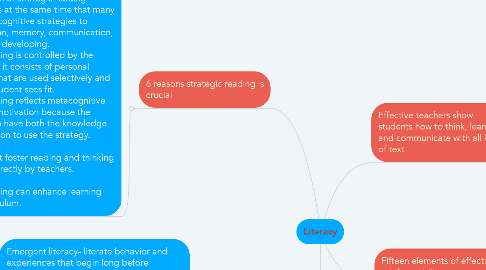Literacy
by Alec Durkin

1. 6 reasons strategic reading is crucial
1.1. 1. It allows elaborating, organizes, and evaluate what is being learned from the text. 2. The acquisition of strategic reading strategies occurs at the same time that many of the student’s cognitive strategies to enhance attention, memory, communication, and learning are developing. 3. Strategic reading is controlled by the student because it consists of personal cognitive tools that are used selectively and flexible as the student sees fit. 4. Strategic reading reflects metacognitive awareness and motivation because the student needs to have both the knowledge and the disposition to use the strategy. 5. Strategies that foster reading and thinking can be taught directly by teachers. 6. Strategic reading can enhance learning across the curriculum.
2. Four Aspects of Literacy
2.1. Emergent literacy- literate behavior and experiences that begin long before schooling, a child's first time reading and writing. Functional- denotes the ability to read and write in one's environment, more specific place, workplace literacy Knowledge- in specific areas, makes special demands on participants that may change dramatically as they move to a new setting Content-ability to use reading and writing for the acquisitions of new content in a given discipline
3. Effective teachers show students how to think, learn, and communicate with all kinds of text
3.1. Strong content knowledge Knowledge of how to teach others Understanding learners and they're learning and development Adaptive expertise, allowing for making judgements
4. Fifteen elements of effective adolescent lit programs
4.1. 1. Direct, explicit comprehension instruction 2. Effective instructional principles embedded in the content 3. Motivation and self-directed learning 4. Text-based collaborative learning 5. Strategic tutoring 6.Diverse texts 7. Intensive writing 8. Technology 9. Ongoing formative assessments 10. Extended time 11. Professional development 12. Ongoing summative assessments 13. Teacher teams 14. Leadership 15. The comprehensive and coordinated literacy program


